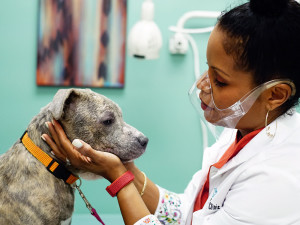Everything You Always Wanted to Know About Pet Allergies But Were Afraid to Ask
Dermatologist and star of Pop Goes the Vet Dr. Joya Griffin on the season’s often misunderstood phenomenon.

Share Article
Tissue boxes are flying off the shelves, the streets are filled with sounds of sniffling, and my browser is riddled with tabs telling me whether congestion and runny nose are COVID symptoms. That can only mean one thing: It’s officially allergy season. And as much as we might struggle to cope with this triannual event, it can be even worse for our pets — especially considering that the information on animal allergies is usually vague or unclear, particularly for younger pets. So rather than canvassing Google until I decide my dog also needs to be quarantined, I asked an expert to clear a few things up regarding early canine and feline environmentally induced allergies.
What Allergies Look Like in Pets
Dr. Joya Griffin is a veterinary dermatologist and host of National Geographic’s Pop Goes the Vetopens in new tab. The series follows her as she helps pet parents rectify their animal’s skin issues that tend to fall somewhere between bizarre and disgusting. It’s a professional duty that she admittedly takes a lot of joy in resolving. Often, these dermal cases are the result of allergens, though more common symptoms are far less extreme.
“Unlike the itchy eyes and runny noses that people get, animals’ environmental allergies — a disease called atopy — will have itchy, red, and irritated skin,” Dr. Joya explains. She adds that dogs and cats may lick, bite, scratch, or chew at themselves in response, which can then create secondary infections. In fact, one major issue with treating pet allergies is that these symptoms are not always seen as related to atopy.
Causes of Pet Allergies
According to Dr. Joya, dogs and cats don’t typically have upper respiratory signs from these conditions, so it can be difficult to interpret this consistent itching and recurrent skin infections as those related to allergies. Making matters worse, or more accurately more confusing, these allergies commonly do not surface until the animal is at one or two years of age. “It takes a first exposure to an allergen for the immune process to start and then on re-exposure the dog or cat will start to have symptoms due to this abnormal immune response,” Dr. Joya explains.

Pollen, molds, grass, fungi, and certain weeds are all typical allergens for dogs and cats. Beyond those, many pets can develop a flea allergy, so Dr. Joya advises staying on top of flea prevention and ensuring your pup or kitten is receiving their year-round treatment as directed by their veterinarian. Additionally, the itching from these contagious mites is regularly confused with allergies, so this will minimize the risk of misdiagnosis.
Breeds That Are Prone to Allergies
Of course, there’s also the breed aspect of all this to consider. As any Pittie parent can tell you, some breeds are just predisposed to environmental allergies — especially when it comes to dogs. At Dr. Joya’s practice, the breeds they see at a higher-than-average clip for allergies are English Bulldogs, Doodles, German Shepherds, Shih Tzus, and Terriers. The main cause of this occurrence is the same reason why I gravitate toward Irish whiskey — genetics. “Environmental allergies are caused by genetic factors, so certain breeds are overrepresented,” Dr. Joya explains. If you recently adopted or plan to adopt any of these highly allergic breeds, she recommends vigilantly watching for any signs of allergies, such as ear infections or skin irritation, and swiftly seeking veterinary attention if any appear.
Treatments For Pet Allergies
In addition to watching for specific breeds, there are plenty of preparations and treatments that can help minimize the impact of environmental allergies. Just don’t listen to anyone who says they have a cure. “No real way you can prevent it; however, if your pet is diagnosed with environmental allergies, seeking treatment early is important,” Dr. Joya says, before adding that there are medications that can control symptoms. One of the most effective is allergy shots, aka immunotherapy, which can be used to suppress flare-ups. This will also help lower the risk of these worsening as dogs and cats age.
How to Treat Pet Allergies at Home
For at-home options, Dr. Joya points to bathing your pet with an anti-itch or medicated shampoo prescribed by a veterinarian. These products can help restore the skin’s barrier therefore making it less reactive to allergens. Plus, she notes that bathing your pet also removes allergens from their skin and reduces the risk of secondary infection.
But if you’re dealing with a young puppy or kitten who has yet to display symptoms, insurance is pretty much a must. “Pet insurance is great and covers the vast majority of allergy workup and treatment as long as the family has the pet insured before allergy symptoms are treated,” Dr. Joya says. In short, securing insurance early will help ensure that pets are covered once allergies manifest. Otherwise, it will be considered a pre-existing condition and likely will not be covered. “It’s best to do your research early and find the company that meets your pet’s needs and to get a policy as soon as you adopt them,” Dr. Joya adds.

Sean Zucker
Sean Zucker is a writer whose work has been featured in Points In Case, The Daily Drunk, Posty, and WellWell. He has an adopted Pit Bull named Banshee whose work has been featured on the kitchen floor and whose behavioral issues rival his own.
Related articles
![Black puppy itches behind her ear due to flea allergy]()
Shoo, Flea: What to Do About Your Dog’s Disturbing Flea Allergy
Before you say “ewww” Moira Rose-style, learn these steps to prevent and remove fleas.
![A woman sitting in bed holding her Chihuahua dog and blowing her nose into a tissue]()
How to Keep Your Pet Allergies in Check
While keeping your dog or cat at home where they belong.
![Gray and white striped cat is scratching his ear]()
What’s Up With My Cat’s Skin?
Everything you need to know about cat allergies, according to three veterinary dermatologists.
![Three eco-friendly pet grooming products displayed in a collage.]()
11 Eco-Friendly Pet Grooming Products
Package-free brushes, plant-based wipes, certified-organic shampoos, and more.
![Gray and white striped cat is scratching his ear]()
What’s Up With My Cat’s Skin?
Everything you need to know about cat allergies, according to three veterinary dermatologists.






